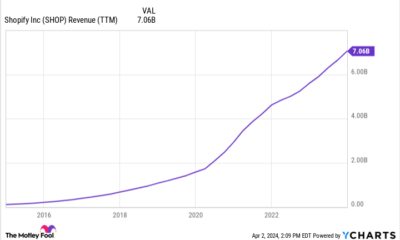A Bull Market May Be Coming: 2 AI Stocks to Buy Hand Over Fist Now

For the past few months, Wall Street has been divided on whether the year 2023 will end with a bull rally or a potential recession. However, popular opinion has slightly tipped in favor of the bullish camp, especially after the preliminary data from the Bureau of Economic Analysis indicated that U.S. real gross domestic product (real GDP, a measure of inflation-adjusted economic activity) grew at an annual rate of 4.9% in the third quarter — the fastest it has grown in the past two years.
In either case, artificial intelligence (AI) continues to be the dominant investment theme of 2023. Since AI is getting deeply embedded in our daily lives and is definitely not a passing trend, it makes sense for investors to opt for stocks with proven and already monetized technologies.
Here’s why Meta Platforms (META 2.56%) and Qualcomm (QCOM 3.42%) fit the bill and can prove to be attractive investments in the long run.
1. Meta Platforms
Shares of social media giant Meta Platforms have seen a meteoric rise of nearly 162% so far in 2023 — a remarkable feat after a pretty turbulent performance in 2022. CEO Mark Zuckerberg’s “year of efficiency” initiative (a focus on aggressive cost-cutting and reducing bureaucracy in 2023), has played a pivotal role in the company’s positive transformation.
Meta’s “family of apps” business segment, which includes social media apps such as Facebook, Instagram, WhatsApp, Messenger, and Threads, continues to be the cash cow and generate a solid stream of advertising revenue. In the third quarter, the segment reported $33.6 billion in advertising revenue, up 24% on a year-over-year basis. The operating income margin of this business was 51.9% in the third quarter, a robust improvement from a 34.3% margin in the same quarter of the prior year.
Meta has been leveraging recommendation AI technology to boost user engagement and monetization across its social media apps. These recommendation improvements have led to a 7% increase in time spent on Facebook and a 6% increase on Instagram in the third quarter. The company is also using AI and machine learning-powered tools, together called Meta Advantage, to help small businesses create impactful ads and enable advertisers to quickly understand the conversion potential of these ads.
Meta is now gearing up to focus on business AI (leveraging AI capabilities in business messaging) in 2024. The company aims to reduce labor costs by setting up business AI chatbots that can help customers with commerce and support activities. Besides bringing in a new revenue stream, business messaging can also help Meta reduce its overreliance on digital advertising.
However, all is not perfect for the company. Previously known as Facebook, Meta changed its name to reflect its interests beyond social media and advertising in other areas such as virtual- and mixed-reality hardware and the metaverse. While the company has invested billions of dollars in these businesses through its Reality Labs division, this business still remains a loss-making venture.
Although this challenge cannot be ignored, Meta also boasts of several advantages such as a broad customer base, ad-pricing power, improved financial health, and robust AI initiatives. In this context, even if the long-term future of Reality Labs is mired with uncertainty, Meta can be considered to be an attractive pick.
2. Qualcomm
Leading mobile chip giant Qualcomm reported mixed results in the fourth quarter of fiscal 2023 (ended Sept. 24). Although the company surpassed consensus revenue and earnings estimates, revenue was still down by 24% year over year to $8.6 billion and adjusted net income declined by 36% year over year to $2.3 billion.
However, things may soon get better in fiscal 2024 — as is evident by the company’s guidance for the first quarter of fiscal 2024 (ending Dec. 25). The company expects revenue to be in the range of $9.1 billion to $9.9 billion, implying a flat performance on a year-over-year basis. This is a significant improvement from the rapid revenue decline posted by the company in the past year. With the company seeing early signs of stabilization in demand for 3G, 4G, and 5G handsets globally, including China, the probability of meeting the guidance remains high.
Qualcomm has also been focusing on developing AI-focused chips for smartphones and Windows 11 personal computers (PCs). The company is making major strides in the on-device generative AI market and has introduced the Snapdragon 8 Gen 3 Neural Processing Unit (NPU) and Snapdragon X Elite CPU to run large language models (LLMs) locally on smartphones and PCs. As the first to release technology that can support LLM models based on billions of data parameters on local machines, Qualcomm has emerged as a leader in on-device generative AI technology for smartphones, PCs, and automobiles.
Qualcomm’s excessive revenue dependence on Apple has been a sore point in its investment thesis. The problem was exacerbated when it became clear that Apple was developing its own 5G chips — to the point where Qualcomm did not forecast any revenue from Apple in 2024. In this context, the recent renewal of the agreement between Qualcomm and Apple to supply Snapdragon 5G processors for smartphone launches in 2024, 2025, and 2026 can prove to be a solid positive for Qualcomm.
Hence, against the backdrop of stabilizing demand for consumer electronics, a potential turnaround in financials, dominance in on-device generative AI, and the renewal of the agreement with Apple, Qualcomm is a smart AI pick now.
Randi Zuckerberg, a former director of market development and spokeswoman for Facebook and sister to Meta Platforms CEO Mark Zuckerberg, is a member of The Motley Fool’s board of directors. Manali Bhade has no position in any of the stocks mentioned. The Motley Fool has positions in and recommends Apple, Meta Platforms, and Qualcomm. The Motley Fool has a disclosure policy.
Facebook Faces Yet Another Outage: Platform Encounters Technical Issues Again

Uppdated: It seems that today’s issues with Facebook haven’t affected as many users as the last time. A smaller group of people appears to be impacted this time around, which is a relief compared to the larger incident before. Nevertheless, it’s still frustrating for those affected, and hopefully, the issues will be resolved soon by the Facebook team.
Facebook had another problem today (March 20, 2024). According to Downdetector, a website that shows when other websites are not working, many people had trouble using Facebook.
This isn’t the first time Facebook has had issues. Just a little while ago, there was another problem that stopped people from using the site. Today, when people tried to use Facebook, it didn’t work like it should. People couldn’t see their friends’ posts, and sometimes the website wouldn’t even load.
Downdetector, which watches out for problems on websites, showed that lots of people were having trouble with Facebook. People from all over the world said they couldn’t use the site, and they were not happy about it.
When websites like Facebook have problems, it affects a lot of people. It’s not just about not being able to see posts or chat with friends. It can also impact businesses that use Facebook to reach customers.
Since Facebook owns Messenger and Instagram, the problems with Facebook also meant that people had trouble using these apps. It made the situation even more frustrating for many users, who rely on these apps to stay connected with others.
During this recent problem, one thing is obvious: the internet is always changing, and even big websites like Facebook can have problems. While people wait for Facebook to fix the issue, it shows us how easily things online can go wrong. It’s a good reminder that we should have backup plans for staying connected online, just in case something like this happens again.
Christian family goes in hiding after being cleared of blasphemy

LAHORE, Pakistan — A court in Pakistan granted bail to a Christian falsely charged with blasphemy, but he and his family have separated and gone into hiding amid threats to their lives, sources said.
Haroon Shahzad, 45, was released from Sargodha District Jail on Nov. 15, said his attorney, Aneeqa Maria. Shahzad was charged with blasphemy on June 30 after posting Bible verses on Facebook that infuriated Muslims, causing dozens of Christian families in Chak 49 Shumaali, near Sargodha in Punjab Province, to flee their homes.
Lahore High Court Judge Ali Baqir Najfi granted bail on Nov. 6, but the decision and his release on Nov. 15 were not made public until now due to security fears for his life, Maria said.
Shahzad told Morning Star News by telephone from an undisclosed location that the false accusation has changed his family’s lives forever.
“My family has been on the run from the time I was implicated in this false charge and arrested by the police under mob pressure,” Shahzad told Morning Star News. “My eldest daughter had just started her second year in college, but it’s been more than four months now that she hasn’t been able to return to her institution. My other children are also unable to resume their education as my family is compelled to change their location after 15-20 days as a security precaution.”
Though he was not tortured during incarceration, he said, the pain of being away from his family and thinking about their well-being and safety gave him countless sleepless nights.
“All of this is due to the fact that the complainant, Imran Ladhar, has widely shared my photo on social media and declared me liable for death for alleged blasphemy,” he said in a choked voice. “As soon as Ladhar heard about my bail, he and his accomplices started gathering people in the village and incited them against me and my family. He’s trying his best to ensure that we are never able to go back to the village.”
Shahzad has met with his family only once since his release on bail, and they are unable to return to their village in the foreseeable future, he said.
“We are not together,” he told Morning Star News. “They are living at a relative’s house while I’m taking refuge elsewhere. I don’t know when this agonizing situation will come to an end.”
The Christian said the complainant, said to be a member of Islamist extremist party Tehreek-e-Labbaik Pakistan and also allegedly connected with banned terrorist group Lashkar-e-Jhangvi, filed the charge because of a grudge. Shahzad said he and his family had obtained valuable government land and allotted it for construction of a church building, and Ladhar and others had filed multiple cases against the allotment and lost all of them after a four-year legal battle.
“Another probable reason for Ladhar’s jealousy could be that we were financially better off than most Christian families of the village,” he said. “I was running a successful paint business in Sargodha city, but that too has shut down due to this case.”
Regarding the social media post, Shahzad said he had no intention of hurting Muslim sentiments by sharing the biblical verse on his Facebook page.
“I posted the verse a week before Eid Al Adha [Feast of the Sacrifice] but I had no idea that it would be used to target me and my family,” he said. “In fact, when I came to know that Ladhar was provoking the villagers against me, I deleted the post and decided to meet the village elders to explain my position.”
The village elders were already influenced by Ladhar and refused to listen to him, Shahzad said.
“I was left with no option but to flee the village when I heard that Ladhar was amassing a mob to attack me,” he said.
Shahzad pleaded with government authorities for justice, saying he should not be punished for sharing a verse from the Bible that in no way constituted blasphemy.
Similar to other cases
Shahzad’s attorney, Maria, told Morning Star News that events in Shahzad’s case were similar to other blasphemy cases filed against Christians.
“Defective investigation, mala fide on the part of the police and complainant, violent protests against the accused persons and threats to them and their families, forcing their displacement from their ancestral areas, have become hallmarks of all blasphemy allegations in Pakistan,” said Maria, head of The Voice Society, a Christian paralegal organization.
She said that the case filed against Shahzad was gross violation of Section 196 of the Criminal Procedure Code (CrPC), which states that police cannot register a case under the Section 295-A blasphemy statute against a private citizen without the approval of the provincial government or federal agencies.
Maria added that Shahzad and his family have continued to suffer even though there was no evidence of blasphemy.
“The social stigma attached with a blasphemy accusation will likely have a long-lasting impact on their lives, whereas his accuser, Imran Ladhar, would not have to face any consequence of his false accusation,” she said.
The judge who granted bail noted that Shahzad was charged with blasphemy under Section 295-A, which is a non-cognizable offense, and Section 298, which is bailable. The judge also noted that police had not submitted the forensic report of Shahzad’s cell phone and said evidence was required to prove that the social media was blasphemous, according to Maria.
Bail was set at 100,000 Pakistani rupees (US $350) and two personal sureties, and the judge ordered police to further investigate, she said.
Shahzad, a paint contractor, on June 29 posted on his Facebook page 1 Cor. 10:18-21 regarding food sacrificed to idols, as Muslims were beginning the four-day festival of Eid al-Adha, which involves slaughtering an animal and sharing the meat.
A Muslim villager took a screenshot of the post, sent it to local social media groups and accused Shahzad of likening Muslims to pagans and disrespecting the Abrahamic tradition of animal sacrifice.
Though Shahzad made no comment in the post, inflammatory or otherwise, the situation became tense after Friday prayers when announcements were made from mosque loudspeakers telling people to gather for a protest, family sources previously told Morning Star News.
Fearing violence as mobs grew in the village, most Christian families fled their homes, leaving everything behind.
In a bid to restore order, the police registered a case against Shahzad under Sections 295-A and 298. Section 295-A relates to “deliberate and malicious acts intended to outrage religious feelings of any class by insulting its religion or religious beliefs” and is punishable with imprisonment of up to 10 years and fine, or both. Section 298 prescribes up to one year in prison and a fine, or both, for hurting religious sentiments.
Pakistan ranked seventh on Open Doors’ 2023 World Watch List of the most difficult places to be a Christian, up from eighth the previous year.
Morning Star News is the only independent news service focusing exclusively on the persecution of Christians. The nonprofit’s mission is to provide complete, reliable, even-handed news in order to empower those in the free world to help persecuted Christians, and to encourage persecuted Christians by informing them that they are not alone in their suffering.
Free Religious Freedom Updates
Join thousands of others to get the FREEDOM POST newsletter for free, sent twice a week from The Christian Post.
Individual + Team Stats: Hornets vs. Timberwolves
CHARLOTTE HORNETS MINNESOTA TIMBERWOLVES You can follow us for future coverage by liking us on Facebook & following us on X: Facebook – All Hornets X – …
Source link
-

 SEO5 days ago
SEO5 days agoGoogle March 2024 Core Update Officially Completed A Week Ago
-

 WORDPRESS6 days ago
WORDPRESS6 days ago9 Best WooCommerce Multi Vendor Plugins (Compared)
-
SEARCHENGINES7 days ago
Daily Search Forum Recap: April 25, 2024
-

 MARKETING5 days ago
MARKETING5 days agoNavigating the Video Marketing Maze: Short-Form vs. Long-Form
-

 SEO6 days ago
SEO6 days agoGoogle Declares It The “Gemini Era” As Revenue Grows 15%
-
![The Current State of Google’s Search Generative Experience [What It Means for SEO in 2024] person typing on laptop with](https://articles.entireweb.com/wp-content/uploads/2024/04/The-Current-State-of-Googles-Search-Generative-Experience-What-It.webp-400x240.webp)
![The Current State of Google’s Search Generative Experience [What It Means for SEO in 2024] person typing on laptop with](https://articles.entireweb.com/wp-content/uploads/2024/04/The-Current-State-of-Googles-Search-Generative-Experience-What-It.webp-80x80.webp) MARKETING6 days ago
MARKETING6 days agoThe Current State of Google’s Search Generative Experience [What It Means for SEO in 2024]
-

 SEARCHENGINES6 days ago
SEARCHENGINES6 days agoGoogle March 2024 Core Update Finished April 19, 2024
-
SEARCHENGINES4 days ago
Daily Search Forum Recap: April 26, 2024















